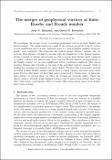Files in this item
The merger of geophysical vortices at finite Rossby and Froude number
Item metadata
| dc.contributor.author | Reinaud, Jean N. | |
| dc.contributor.author | Dritschel, David G. | |
| dc.date.accessioned | 2018-12-05T00:50:58Z | |
| dc.date.available | 2018-12-05T00:50:58Z | |
| dc.date.issued | 2018-08-10 | |
| dc.identifier | 252913149 | |
| dc.identifier | 2e2336a5-191b-4e0f-ab1c-5f6e57896c02 | |
| dc.identifier | 85048043368 | |
| dc.identifier | 000434376100003 | |
| dc.identifier.citation | Reinaud , J N & Dritschel , D G 2018 , ' The merger of geophysical vortices at finite Rossby and Froude number ' , Journal of Fluid Mechanics , vol. 848 , pp. 388-410 . https://doi.org/10.1017/jfm.2018.367 | en |
| dc.identifier.issn | 0022-1120 | |
| dc.identifier.other | ORCID: /0000-0001-5449-6628/work/45557824 | |
| dc.identifier.other | ORCID: /0000-0001-6489-3395/work/64697783 | |
| dc.identifier.uri | https://hdl.handle.net/10023/16629 | |
| dc.description | Partial support for this research has come from the UK Engineering and Physical Sciences Research Council (grant number EP/H001794/1). | en |
| dc.description.abstract | We investigate the merger of two co-rotating geophysical vortices at finite Rossby and Froude number. The initial conditions consist of two uniform potential vorticity vortices in near-equilibrium and in a nearly ‘balanced’ state (i.e. with negligible emission of inertia–gravity wave radiation). We determine the critical merger distance between the two vortices. This distance is found to increase with the magnitude of the Rossby number: intense cyclones or intense anticyclones are able to merge from further apart compared to weaker cyclones and anticyclones. Note that the Froude number is proportional to the Rossby number for the near-equilibrium initial conditions considered. The critical merging distance also depends on the sign of the potential vorticity anomaly, which is positive for ‘cyclones’ and negative for ‘anticyclones’. We show that ageostrophic motions occurring at finite Rossby number tend to draw cyclones together but draw anticyclones apart. On the other hand, we show that anticyclones tend to deform more, in particular when subject to vertical shear (as when the vortices are vertically offset). These two effects compete. Overall, nearly aligned cyclones tend to merge from further apart than their anticyclonic counterparts, while vertically offset anticyclones merge from further apart than cyclones. | |
| dc.format.extent | 23 | |
| dc.format.extent | 3678823 | |
| dc.language.iso | eng | |
| dc.relation.ispartof | Journal of Fluid Mechanics | en |
| dc.subject | Rotating flows | en |
| dc.subject | Stratified flows | en |
| dc.subject | Vortex dynamics | en |
| dc.subject | QE Geology | en |
| dc.subject | QA Mathematics | en |
| dc.subject | NDAS | en |
| dc.subject | BDC | en |
| dc.subject | R2C | en |
| dc.subject.lcc | QE | en |
| dc.subject.lcc | QA | en |
| dc.title | The merger of geophysical vortices at finite Rossby and Froude number | en |
| dc.type | Journal article | en |
| dc.contributor.sponsor | EPSRC | en |
| dc.contributor.institution | University of St Andrews. Applied Mathematics | en |
| dc.contributor.institution | University of St Andrews. Scottish Oceans Institute | en |
| dc.contributor.institution | University of St Andrews. Marine Alliance for Science & Technology Scotland | en |
| dc.identifier.doi | 10.1017/jfm.2018.367 | |
| dc.description.status | Peer reviewed | en |
| dc.date.embargoedUntil | 2018-12-05 | |
| dc.identifier.grantnumber | EP/H001794/1 | en |
This item appears in the following Collection(s)
Items in the St Andrews Research Repository are protected by copyright, with all rights reserved, unless otherwise indicated.

